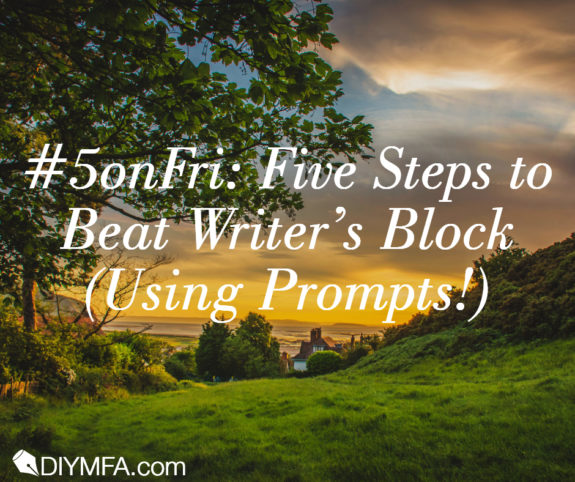It’s easy to take writing prompts for granted. Maybe because they’re so abundant, we wonder if they can really help that much. Maybe it’s because they’re so fun, it’s hard to take them seriously. Those suffering from writer’s block especially seem to go to extremes in their approach to prompts.
On one side, blocked writers either consume prompts by the bookload, hoping one will magically dissolve their block and allow a story to pour forth. On the other extreme are blocked writers who dismiss prompts as amateurish or too silly to inspire a serious work of art.
But it’s these blocked writers who need writing prompts the most. Because prompts, when used correctly, can inch us forward through all the anxieties that manifest as writer’s block.
When I first started research for my book, Landing Your First Publication, reader surveys through my platform pointed to a slew of anxieties that kept them from writing. But no matter the anxiety we uncovered—perfectionism, fear of failure, fear of success, the indignity of being a beginner—the most helpful solutions were those that reduced the pressure and restored the sense of curiosity and the drive to explore.
That’s why I built Landing Your First Publication and its low-pressure approach to writing and submitting around a core of strong writing prompts.
Here’s how you can use its writing prompts (or any other prompts you love) to beat writer’s block for good.
1) Get that first image onto the page
One of the greatest battle cries in Landing Your First Publication is to write down the first image or phrase that pops into your head when you first read a prompt. Because, for many blocked writers, the problem isn’t a lack of ideas. It’s that we shoot down the ideas the muse serves up to us.
The method inside Landing Your First Publication asks writers to avoid the impulse to reject that first image or phrase no matter how cliche it may seem at first or how unlikable it makes a character. This allows us to quiet our critical inner editor’s voice and only take dictation of what we see and hear.
Besides, the first image we get from a prompt is often a guidepost. There’s nothing to do but to follow it to the next step.
2) Use your first image as a prompt
Now that you have that first image on the page, where do you go?
Read what you wrote as though it were a writing prompt. What image or character action pops into your head? Get it onto the page.
Remember, you’re not “allowed” to judge these gifts from your subconscious (humor me if that idea sounds silly to you). Your only job is to get those images and phrases down. Sometimes, if no image or character action materializes, I’ve found it helpful to ask myself “what does this character want?”
These two techniques can help you get through an entire first draft.
3) Keep all of your “mistakes”
We’re never more obsessed with spelling and technicalities of grammar as when we’re in the middle of a brutal episode of writer’s block.
For me, this is so consistent that I can often gauge the severity of writer’s block by the severity of my fixation on spelling and grammar. Fixating on technicalities of grammar and spelling makes us feel like we’re writing without actually doing the emotional work of pushing through anxiety and uncertainty.
Keeping your “mistakes,” or better yet ignoring them in the first draft, makes room for you to focus on the work of storytelling. Rest assured any mistakes will be cleaned up in a later draft.
There’s a bonus reason for ignoring those “mistakes” we’ll cover in a moment.
4) Ignore literary theory + writing rules
I love reading about new writing techniques as much as the next writer. My BA is in English lit, which was basically just an excuse for me to read fiction and theory and call it studying. But those perfect plot structures and character arcs don’t always belong in your first draft.
When Landing Your First Publication was chosen to be the main text in a college creative writing course, I wondered if it was “academic” enough to be useful in a college setting. It avoids the bog of theory and technique that traditional writing references explore and is anything but academic.
But it’s this fun, stripped-down approach that makes it and other writing prompts a wonderful resource for new and blocked writers.
As you’re working with your prompt, embrace the curiosity and drive to explore that called you to write in the first place. Because it’s the practice of writing that makes us better writers. Worries over literary theory and writing techniques don’t belong in the first draft.
5) Mine your “mistakes” for clues
Mistakes aren’t really mistakes when they’re in the first draft. “Mistakes” are clues.
Plot gaps hide events your characters have been keeping secret from you. Spelling errors may reveal a character’s background, education, or associations that could change the meaning of your story.
“Mistakes” could be seeds that set off entire chains of events. “Mistakes” can be guideposts when you’re stuck. Or they can take your story in directions that surprise even you.
Approaching your first draft with this fun, Landing Your First Publication way means you can use these “mistakes” for the glorious little opportunities they truly are.
Try it, and you’ll be able to use writing prompts to inch through writer’s block every time.

Mandy Wallace shares writing tips, resources, and industry interviews with the 20k monthly readers of Write or Die, named one of the 100 Best Websites for Writers. Her book, Landing Your First Publication: The Writing Prompts + Publication Strategy for Writers Who Refuse to Rely on Luck, is available on Amazon.







